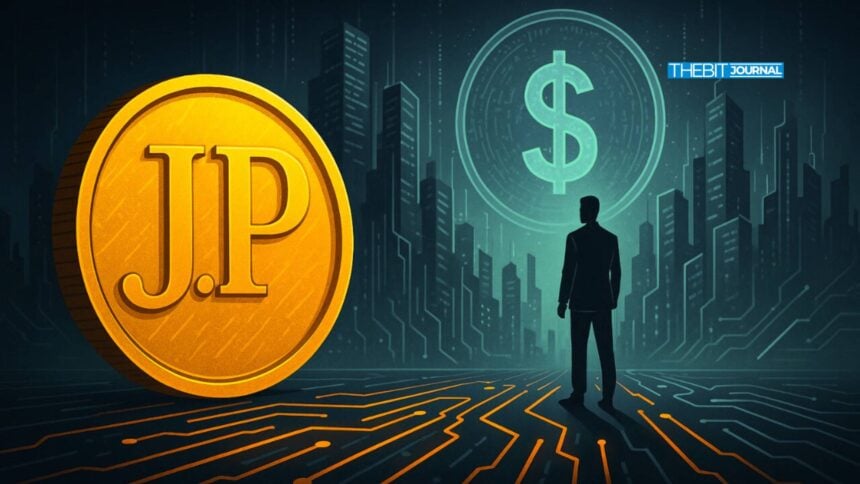According to a recent report, JPMorgan stablecoin services are entering a new testing phase aimed at improving payment settlements for institutional clients. This development reflects the growing trend of traditional financial giants entering the digital asset space, not just to compete with fintech but to maintain control over the future of money.
Why JPMorgan Is Moving Toward Stablecoin Services
The financial sector is undergoing rapid change, and banks recognize the need to adapt. JPMorgan’s decision to test both stablecoin services and a proprietary deposit token (JPMD) is its latest push to stay ahead. The bank’s leadership believes this could be the key to speeding up payment systems and offering more secure, efficient transaction options.
“We’re responding to changing client needs in a digital environment,” JPMorgan CEO Jamie Dimon said in the Q2 earnings call.
The JPMorgan stablecoin services will be tested on public blockchains, including Base (an Ethereum Layer 2 network developed by Coinbase). This signals JPMorgan’s willingness to work with open technologies; a move that traditional banks have often shied away from.

JPMorgan Deposit Token (JPMD) vs. Regular Stablecoins
The JPMorgan deposit token, known as JPMD, is not just another stablecoin. It represents actual deposits held at JPMorgan, and clients can earn interest on it unlike most traditional stablecoins. It’s currently available only to JPMorgan clients and is limited to transactions within the bank’s ecosystem.
The table below compares key features:
| Feature | JPMD Token | Traditional Stablecoin |
|---|---|---|
| Backed By | Bank Deposits | USD or asset reserves |
| Interest Earning | Yes | No |
| Usage | Within JPMorgan’s network | Global (depends on issuer) |
| Blockchain | Base (Ethereum L2) | Varies (Ethereum, Solana, etc) |
This setup aims to help clients transfer money more quickly across accounts while still staying within the regulatory comfort zone of JPMorgan.
Regulatory Eyes and Market Reactions
The global financial community is watching closely. While JPMorgan stablecoin services may offer speed, critics argue that they don’t solve a key problem: interoperability. A token like JPMD works well but only if both parties are JPMorgan clients.
According to the source, analysts believe this model is not a complete breakthrough but rather a cautious innovation: “The real test is when two banks need to settle across networks. That’s when real disruption happens.”
Still, the crypto market reacted with curiosity. Analysts speculate that if more banks follow JPMorgan’s lead, stablecoins and deposit tokens could gain mainstream momentum.

What It Means for Crypto Users
For crypto users and developers, JPMorgan stablecoin services mark a new type of challenge, an opportunity. These services won’t replace crypto-native tokens, but they could bring in more institutional use cases.
While JPMD may never end up in a personal wallet like USDC or Tether, its impact on cross-border B2B payments could be substantial. As banks test the waters, the crypto industry will need to strike a balance between strike between innovation and regulation.
Conclusion
Based on the latest research, JPMorgan stablecoin services are more than a technological upgrade. They’re a calculated step in redefining how institutional money moves. By embracing blockchain while preserving control, JPMorgan is not just joining the digital revolution; it’s shaping it from within.
Whether this strategy creates lasting infrastructure or remains a limited use-case tool, it highlights the urgency for all financial players to evolve. In the months ahead, crypto readers and institutional stakeholders alike will be watching closely.
For more updates and detailed insights into the world of cryptocurrencies, check out our latest articles.
Summary
JPMorgan is testing blockchain-based stablecoin services and a deposit token (JPMD) to speed up institutional payments. Built on the Ethereum Layer 2 network Base, this move shows JPMorgan’s shift toward open technology. While limited to bank clients, the initiative signals a broader change in how traditional finance may adopt crypto tools for real-world use. It’s a cautious but meaningful step toward faster, more secure digital transactions.
FAQs
What are JPMorgan stablecoin services?
They are blockchain-based solutions, including a deposit token (JPMD), to enable faster and more secure payments within JPMorgan’s ecosystem.
Can the public use the JPMD token?
No, it’s currently limited to JPMorgan’s institutional clients.
How is JPMD different from USDC or Tether?
Actual bank deposits back JPMD and may earn interest, whereas reserves backing USDC and Tether don’t offer interest.
Glossary of Key Terms
Stablecoin: A digital token pegged to the value of fiat currency like the US dollar.
Deposit Token: A blockchain-based representation of a deposit held at a bank.
Blockchain: A decentralized digital ledger that records transactions across multiple computers.
Ethereum Layer 2 (L2): A scaling solution built on top of Ethereum to process transactions faster and more cheaply.
Sources/References





























